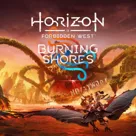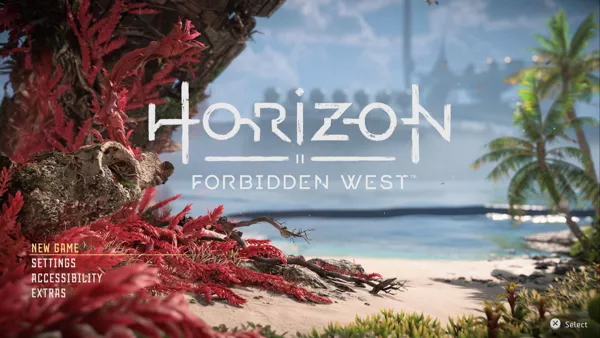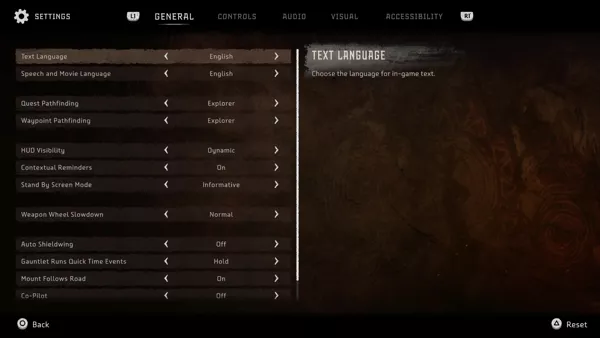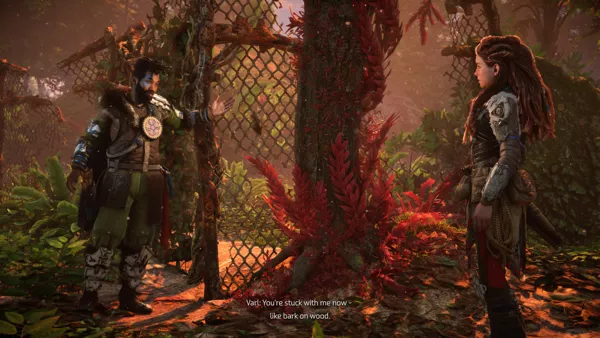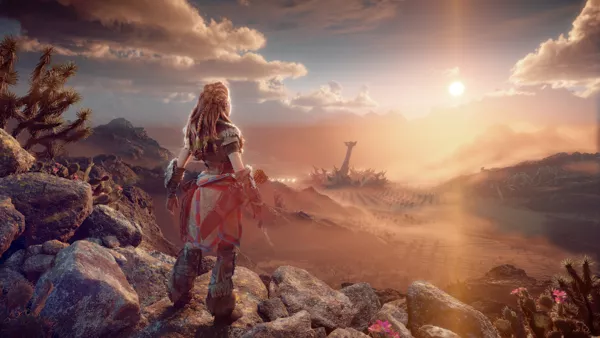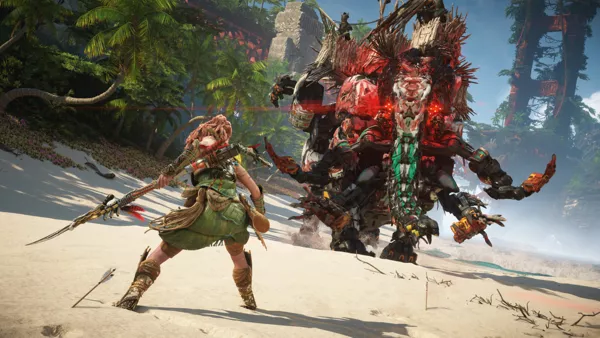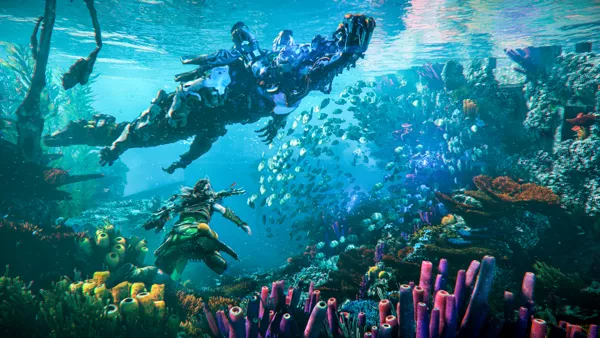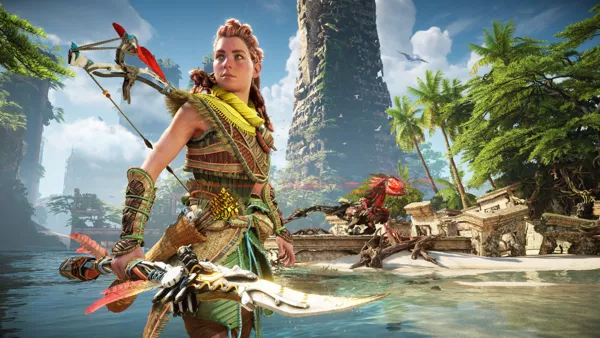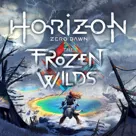Horizon II: Forbidden West
Official Description (Ad Blurb)
To play this game on PS5, your system may need to be updated to the latest system software. Although this game is playable on PS5, some features available on PS4 may be absent. See PlayStation.com/bc for more details.
Edition includes:
Source: PlayStation Store Description
Spellings
- Horizon Запретный Запад - Common Russian spelling
- هورايزن الغرب المحظور - Common Arabic spelling
- 地平線 西域禁地 - Common Traditional Chinese spelling
- 地平线 西之绝境 - Simplified Chinese spelling
- 호라이즌 포비든 웨스트 - Common Korean spelling
Groups +
Screenshots
Promos
Videos
See any errors or missing info for this game?
You can submit a correction, contribute trivia, add to a game group, add a related site or alternate title.
Credits (PlayStation 5 version)
3,446 People (3,367 developers, 79 thanks) · View all
| Executive Producer | |
| Studio Art Director | |
| Technical Director | |
| Game Director | |
| Studio Narrative Director | |
| Art Director | |
| Production Director | |
| Assistant Game Director | |
| Core Design Lead | |
| Core Design | |
| Additional Core Design | |
| Combat Design Lead | |
| Combat Design | |
| Additional Combat Design | |
| Quest Design Lead | |
| Quest Design | |
| [ full credits ] | |
Reviews
Critics
Average score: 88% (based on 37 ratings)
Players
Average score: 4.6 out of 5 (based on 7 ratings with 1 reviews)
The Good
* A massive, hefty game with a lot to see and do - much of it of high quality
-
Graphically impressive and artistically diverse world
-
Combat is as fun as ever, now with plenty of new toys and enhancements to melee mechanics
-
Side characters are wonderfully fleshed-out
The Bad
* Overall story isn't as compelling or believable as Zero Dawn. Main missions take way too long to complete on average. -
Locking exploration and side content behind key items is unnecessary and poorly signposted
-
Weapon/Outfit upgrade mechanics are unnecessarily tedious
-
Some minor graphical glitches/crashes
The Bottom Line
5 years have passed since Guerrilla Games introduced one of gaming’s best new IPs with Horizon Zero Dawn, a rookie entry into the open world action/RPG genre that stood toe-to-toe with and in some cases surpassed some of the genre’s biggest and longest-standing names. Now, after several pandemic-induced delays, the series makes its next-gen debut with the sequel Horizon Forbidden West, which not only continues Aloy’s story from where the first left off, but also overhauls and expands the gameplay systems of the first. The end result is an impressively fleshed-out and exhaustively indulgent sequel that should please most fans of the first game, although there are a few aspects which might leave some scratching their head.Taking place six months after Zero Dawn’s ending, the new title sees Aloy, now having accepted her responsibility and lineage as Earth’s protector, on the hunt for a way to stop a deadly red blight from consuming the Earth. Her search eventually takes her beyond the Carja Sundom into the Forbidden West, where she gets caught up in a civil war between the Tenakth clans instigated primarily by Regalla, all the while investigating a mysterious technologically advanced group of new arrivals who wish to take control of the planet’s terraforming systems for themselves.
Part of the fun is seeing Aloy rediscover and meet up with characters from Zero Dawn. Though there is a recap of the first game’s basic plot points presented for newcomers once you boot up the game for the first time, you’ll appreciate this game a whole lot more if you have played Zero Dawn. I had just finished a replay of the first game the night before this released, and having everything about it fresh in my mind, I appreciated the numerous callbacks and character moments presented in Forbidden West so much more.While Zero Dawn’s story followed two main threads, one in the present and one in the past, Forbidden West’s focus lies mostly on the here and now. You’ll still do plenty of delving into the ruins of “The Metal World”, but the strong mystery element that made the first game’s story work so well has been somewhat downplayed here. There’s certainly a lot of past lore to uncover, but the emphasis is less on Aloy’s journey of self-discovery and more about renewing and healing the post-apocalyptic world. It’s certainly not bad, but it simply isn’t quite as compelling as what came before. Some may also feel that certain plot aspects drift too far into the realm of science-fantasy, compared to the relatively grounded feel of Zero Dawn. There are also some pacing issues: most main missions can take up to an hour or more to complete, so be ready for a long, long sit if you plan on advancing the story, especially if you plan on talking to every character and asking every question (and believe me, if you’re a fan like I am, you’ll want to).
That being said, while the main plot may be a bit slack, the side characters really shine in this installment. Each of your companions is far more fleshed out, with top quality voice acting for nearly all of them (minus one later character) and all of them represent different factions within the game’s world. At some point during the game, you’ll establish a base where you can carry out optional conversations with each of your companions, which turns out to be a nice Mass Effect-influenced touch, since there’s so much dialogue to go through and you can really get a sense of what each one represents.I’ve always maintained that Horizon was meant to be Sony’s answer to the Legend of Zelda, and Forbidden West doubles down on that comparison even more than the first game, although in ways that might be a bit to its detriment. Key items and gadgets for traversal and progression play a much bigger part in this game than they did in the first. I’m sure you’ve seen the glider that Aloy uses in this game (I wonder where Guerrilla got that idea from), but that’s just one of several new tools you get over the course of the journey, including the pullcaster, which is essentially the Hookshot, and a device which allows Aloy to breathe indefinitely underwater. On the one hand, this results in a bit of a different feeling for exploration compared to the first game, especially early on. It brings back the thrill of the pre-Breath of the Wild Zelda games, giving you an incentive to return to places you thought you had thoroughly explored. On the other hand, the number of times I ran across a ruin or a cave I could not explore due to not having the correct equipment was more excessive than I would have liked.
Not only is this approach fundamentally different from the first game’s, which hardly ever locked off anything until you had completed certain main missions, it also compromises the sense of freedom and exploration that the first game did so well, and I’m not completely sure why this change was made. The worst moment was when I started a side mission which was impossible to complete because I did not have the underwater breathing upgrade - I’ve never had to just up and walk away from a Horizon mission while I’m in the middle of it until now. I wish the game had done a better job at actually signposting, or at least blocking these areas off before you decide to investigate them, as the number of times the game says “no” is way more than it should be. Still, given how large and expansive the world is, and how much there is to see and do, it’s a minor gripe in the grand scheme of things.Combat is similar to the first game at first glance, but there have been a lot of changes under the hood. Your weapon wheel now allows you to store up to six different weapons in your loadout, and considering the exponential amount of new ammo types, you’re going to want to make full use of those slots. New combat mechanics include Weapon Techniques, which are special attacks you can use with each weapon type, and Valor Surges, which are unlocked on each skill tree and can be used once your Valor Gauge builds up. These can really turn the tide of combat when they’re used correctly, especially when used at max level. The game introduces many new and returning machine types from the first. Human combat has also been beefed up considerably: where in the first game most human enemies were paper bags that would go down in a couple of hits, here they’re bulked out in armor, use shields and heavy weapons, and won’t just flinch from a headshot with a basic bow. Some of them also ride on machines, which means you’ll often need to deal with the machine as well when fighting them.
Melee has also been hugely overhauled from the first game, with more emphasis placed on using specific combos to gain the upper hand. Spear attacks are generally weaker than those in the first game, so you’ll really need to pump points into the warrior tree and associated outfits and keep the combos in mind to make yourself an effective melee fighter, even as the emphasis largely remains on ranged combat. As an example, one special move Aloy can do is a Resonance Blast - by hitting enemies with melee attacks, her spear can build up energy, which you can place on an enemy and hit with a projectile to score massive damage. It all comes back to your aiming skills. That being said, the absence of any sort of block feature is puzzling: melee combat is meant to be more of a complement rather than the main approach, but the inclusion of several difficult melee only activities means your only defense is dodging constantly without so much as a block or parry function.
Another major change comes in the game’s RPG mechanics and skill systems. In an attempt to encourage build diversity, there are now six skill trees to choose from, and you can choose from a mix of passive bonuses, active skills, Weapon Techniques, and Valor Surges, which are unique to each tree. Outfits not only provide various types of defense, but also enhance the attributes of these individual trees. To be honest, this is a double-edged sword: I loved that the game presented me with more choices, and having Weapon Techniques and Valor Surges unique to each tree means that no two players are going to have the exact same loadout. On the other hand, the skill upgrades from the first game felt much more meaningful: the majority of upgrades here are passive bonuses or situational skills that you’ll hardly notice while playing, and some trees are just objectively better than others. Thankfully, most of the skills which were previously locked behind upgrades in the first are now given to Aloy by default in this game, though for some reason it’s never explained why she chose to drop most of her old equipment.
Weapons also require considerable amounts of resources to upgrade to maximum strength and utilize all of their mod slots, which means you’ll really need to be sure you want to invest more in a weapon before upgrading it, a hard decision to make when the game is often showering you with new weapons after completing quests. This game wants you to exercise restraint in killing machines: tearing off certain parts before they are killed, and making sure you don’t destroy containers for easy explosions, although this can be adjusted in the difficulty settings if you so desire. You can create jobs to keep track of the upgrades that you want as well as possible locations to collect the materials that you need, although there is no way to quickly view these once you’re out in the wild, which feels like a quality of life oversight. The slow upgrade process for weapons meant that I always felt like I was somewhat behind the curve, especially the further I got into the game, when several missions grant new armor and weapon types. There’s isn’t much incentive to actually browse the shops, as completing quests usually gives weapon and gear types that are just as functional.All of these changes combined make for a much more difficult game than its predecessor. Zero Dawn was not a cakewalk, but it was much more manageable once you got to grips with its mechanics. Not only does Forbidden West completely overhaul those mechanics, forcing you to learn the game all over again, it’s also just a more difficult experience in general. Some of the new machines are downright terrifying to face, especially without a companion in tow, and making full use of Weapon Techniques and Valor Surges is essential for survival. I think I spent over an hour on one particular fight. It wasn’t until very late in the game, that having built up my arsenal and unlocked Weapon Techniques for each of my weapons did I truly begin to feel comfortable with consistently taking on the biggest machines.
The game’s climbing system has also been overhauled, although this can prove to be a bit finicky to use at times. In the first game, Aloy could only climb along preset paths which either consisted of yellow climbable objects and white ledges. Despite early trailers indicating the game seemingly adopting Breath of the Wild’s climb-anywhere mechanics, it’s ultimately a slight variation of the first game’s system, and not always for the better. When climbing, you’ll often have more directions which you can move in, but you’re still only able to climb specific walls and cliffs, meaning it’s effectively the same. The yellow lines used to highlight climbable areas can sometimes be difficult to read, and there were several moments where it seemed like Aloy should be close enough to grab something or climb up a ledge, yet she won’t. Or, she will hang off certain ledges at funky angles. It just isn’t as refined as it should be, especially when you compare it to the competition. At least there’s an attempt to introduce some new platforming mechanics, including wall jumps and backwards leaps, although with the exception of using the pullcaster you’re rarely required to actually use these during traversal.
Zero Dawn had no shortage of optional side content for the player to engage with, and Forbidden West easily goes a step or two beyond what that first title offered. This is a HUGE game with so much to do, and almost all of it at a consistently high level of quality. Most of the classic activities return, including Cauldrons, Hunting Grounds, Vantage Points, and Bandit Camps (here called Rebel Camps and Rebel Outposts). But there’s so much more beyond those. The new offerings include Melee Pits, where you can practice and battle against various opponents using the melee combat techniques, eventually working your way up to battling “the Enduring”; Relic Ruins, puzzle areas which are essentially this game’s take on Breath of the Wild’s Shrines; and Machine Strike, a chess-like board game where players collect and battle machine pieces on various boards, utilizing the terrain and skill types to claim victory. Perhaps the most challenging activity is the Arena, which is found in roughly the middle of the game and allows you to go up against the game’s toughest machines in timed combat trials. All that on top of numerous side quests and errands, of course, many of which offer either interesting bits of lore or great rewards, including new and unique weapon types. Once you get into the swing of things, it’s hard to stop.
Though it’s now a five-year old game, Zero Dawn is still up there with the best looking titles, so it’s no surprise that the sequel is even better. Some might be bummed that Forbidden West is a cross-gen game rather than the full next-gen sequel that was anticipated, but honestly, Forbidden West looks better than most games coming out today even on the PS4. The main upgrades for the PS5 version are resolution and framerate. You can either choose to run the game at full 4K or at a lower resolution with a mostly-fluid 60 fps framerate. Either way, the game is stunning.
It’s not just in the technical aspects, the art and design of the game is incredibly eye-catching throughout. Some of the settlements have incredibly unique and dense designs that I’ve never seen in a video game before, and they’re usually populated with more NPCs compared to the first game. Cutscenes are more dynamic than the original, allowing characters to move around and really express their emotions in ways the more limiting Zero Dawn could not. The PS5 version also takes advantage of the controller’s haptics and adaptive triggers to give extra oomph to sensations. You’ll feel the tightness of a bowstring as a weapon gets overdrawn, and the bulkiness of aiming a heavy weapon. There are also several major Uncharted-style action setpieces sprinkled throughout, which gives the game a greater sense of scale and spectacle than its predecessor. And, yes, the water is much, much better looking here than it was in the first game - deep, blue, and reflective.
I have noticed a few visual bugs such as pop-in, sudden black screens, and shimmering textures from time to time, but generally speaking the game is more often than not a polished experience. I would have loved to report a perfectly stable experience, but I did suffer a couple of crashes during my playthrough.I may have really nitpicked this game, and in truth there are definitely some things to criticize here, but Horizon Forbidden West is a great experience overall: from the combat to the graphics to the sheer amount of content the game packs in. Yet compared to its predecessor I honestly still think Zero Dawn might be the better game. Forbidden West comes across like an indulgent double album after an artist wins a Grammy (on PS4, the game actually comes on two discs): captivating and expansive, yet messier, rougher and lacking in the tightness of craft that won them the accolades in the first place. That being said, Horizon Forbidden West is still a heck of a lot of game for your money, and no fan of the first game should miss out on playing it.
PlayStation 5 · by krisko6 (814) · 2022
Analytics
Upgrade to MobyPro to view research rankings!
Related Sites +
-
Wikipedia: Horizon Forbidden West
article in the open encyclopedia about the game
Identifiers +
Contribute
Are you familiar with this game? Help document and preserve this entry in video game history! If your contribution is approved, you will earn points and be credited as a contributor.
Contributors to this Entry
Game added by Rik Hideto.
Game added February 17, 2022. Last modified April 14, 2024.

